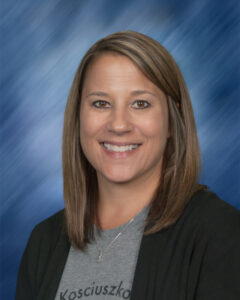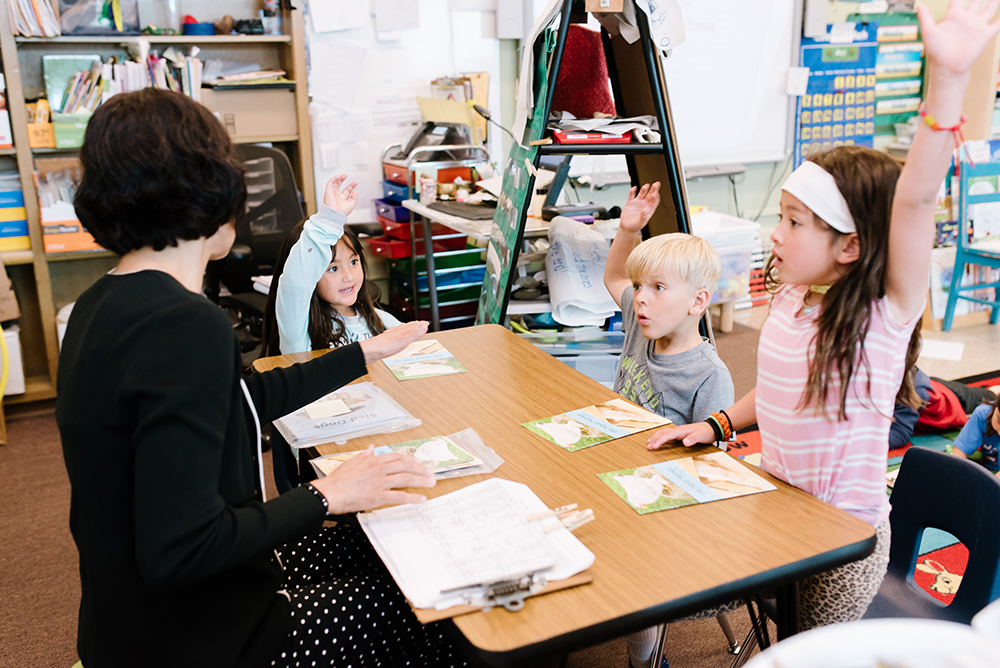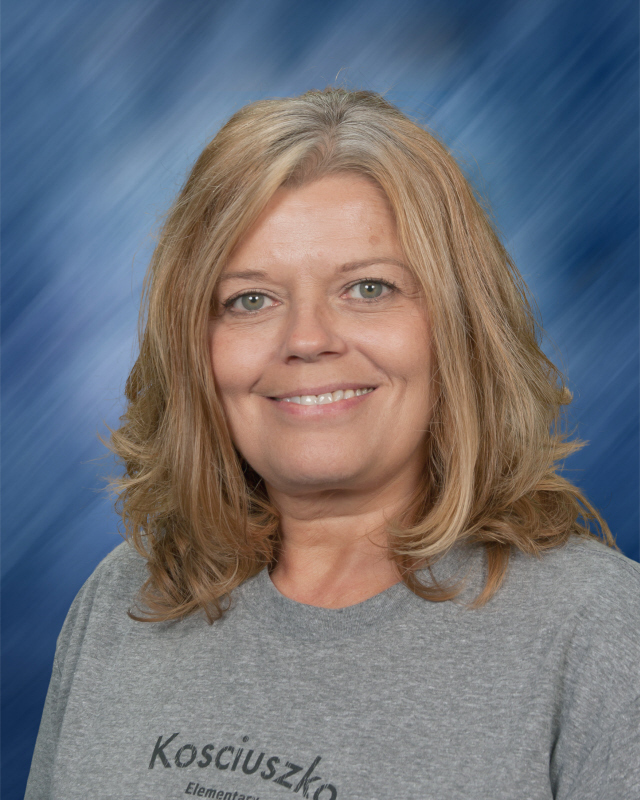In this interview, principal Melissa Kostka and interventionists Charlene Durski and Tina Walworth of Kosciuszko Elementary School in Wisconsin speak about the shift to instruction based in the Science of Reading, share data, and explain how implementing SIPPS® has helped their students. Thank you for speaking with us, Melissa, Charlene, and Tina!

Melissa Kostka, Principal, Kosciuszko Elementary School
Tell us a little about yourself, your school and district, and the students that you serve.
I am Melissa Kostka, principal of Kosciuszko Elementary School. This is my 29th year in education and 23rd year in the School District of Cudahy. I have been honored to be the principal at Kozy for the last eight years.
Kosciuszko is a K4–5th grade school with approximately 200 students. Our population includes 75.2% economically disadvantaged students, 21.3% students with disabilities, and 12.4% English learner students.
What is the most rewarding part of being an educator for you?
Serving the Kosciuszko staff, students, and community is the most rewarding part of being an educator. We are a community committed to literacy and learning for ALL students. We are invested in each and every student, and we celebrate together each time a student reaches another goal.
Tell us about how you started on the journey of shifting to instruction based in the Science of Reading at Kosciuszko Elementary School?
Our journey started just before COVID hit. Our staff had completed a deep dive into our data and knew we were not adequately serving specific populations. We were discouraged by the reality that we could grow students immensely, yet students still needed to reach proficiency. We wanted more for our students and were ready to change.
After COVID, we began working with the consultancy group Schools Cubed to implement Structured Literacy within all elementary schools. School administrators and reading specialists participated in professional development and monthly coaching, as did classroom teachers.
It was a heavy lift! However, we were all in when we saw our middle-of-the-year (MOY) results that first year! Our results were life changing. We had moved the needle for students lingering at the same proficiency for multiple rounds of interventions, including our students with disabilities.

How long has Cudahy been implementing SIPPS? Tell us a little about what the implementation at Kosciuszko Elementary School looks like.
We have implemented SIPPS in Cudahy for the last year and a half [since the 2021–2022 school year]. The reading specialist, interventionists, special education teachers, and classroom teachers were trained.
At Kosciuszko Elementary, our outstanding reading specialist, Candice Johnson, along with our interventionists, Charlene Durksi and Tina Walworth, worked together to become proficient in delivering the intervention. They observed each other and completed fidelity checks to ensure our students got the best.

What do you appreciate about SIPPS?
I appreciate the consistent instructional routines that address phonemic awareness, phonics, and fluency.
What have you noticed about students’ learning and engagement with SIPPS?
Student learning has grown tremendously, in part, due to increased engagement. The routines are consistent, require multiple choral responses, and move at a pace that ensures students receive numerous opportunities to learn the sounds and words.
The routines are consistent, require multiple choral responses, and move at a pace that ensures students receive numerous opportunities to learn the sounds and words.
Talk to me about your reading data. You have seen incredible growth in students.
All of our students — in all demographics — have grown tremendously in one year.
On the Forward Exam, the percentage of all students scoring proficient or advanced went from 22.4% to 42%. The percentage of students with disabilities achieving proficient or advanced went from 4.3% to 21.4%.
Examples of individual students include:
- A 2nd-grade student new to our school this year started the school year reading 3WPM with 33% accuracy. On her most recent progress monitoring assessment, she had 90WPM with 99% accuracy!
How has SIPPS shifted teaching practices and/or professional learning in Kosciuszko Elementary School?
SIPPS has shown us the power of explicit routines and the importance of phonemic awareness and phonics practice.
What thoughts or insights would you share with a school or district that is considering SIPPS?
SIPPS has been a game changer for our staff and students. It is the first intervention program with all the components needed to close the gap for our students.
SIPPS has been a game changer for our staff and students. It is the first intervention program with all the components needed to close the gap for our students.

Charlene Durski, Interventionist
Tell us a little about yourself, your role as an interventionist, and the students that you serve.
I am Charlene Durski. I am an interventionist at Kosciuszko Elementary School.
I have been working in education for the past 35 years. I’ve spent 29 years as a third-grade teacher and the past 6 years as an instructional interventionist. I work with students from K to 5th grade helping them to improve their reading skills.
What is the most rewarding part of being an educator for you?
The most rewarding part of being in education is working with the students and seeing their progress from the beginning of each school year to the end. Seeing students set goals and watching them reach those goals. Making connections with students and helping them be successful in their learning.
How long have you been implementing SIPPS? Tell us a little about your implementation.
I started implementing SIPPS at the end of the 2021–2022 school year. In the beginning, I did struggle a bit, but with help from my colleagues, Tina Walworth and Candice Johnson, I became better at implementing it.
Both Tina and Candice had been doing SIPPS since the beginning of the year, so I was able to observe them doing SIPPS lessons with students. This was very beneficial. Watching the videos that are provided in the lessons are also helpful in knowing how to correctly teach the lessons.
What do you appreciate about SIPPS?
I appreciate the structured and repetitive approach to teaching SIPPS. Each lesson includes phonics skills, sight words, spelling patterns, polysyllabic words, and reading practice.
What have you noticed about your students’ learning and engagement?
I have noticed students work together when responding to the teacher’s cues when doing SIPPS lessons, so it is a group effort, which helps keep them engaged. Students apply the strategies they are learning in SIPPS to decode words and improve their fluency and accuracy in reading.
How has SIPPS affected or changed your own teaching and learning?
SIPPS has affected my teaching as I have applied some of the techniques I have learned in SIPPS when working with students in other reading interventions.
What advice or insights would you share with an educator who is new to SIPPS?
My advice to others new to SIPPS is: take it slow when you begin! Stick to the routine of each lesson and watch the videos that SIPPS provides to help you teach the lessons.

Tina Walworth, Interventionist
Tell us a little about yourself, your role, and the students that you serve.
I am Tina Walworth. I am an interventionist at Kosciuszko Elementary School and have been working in elementary education for 8 years. I work with students from K5 through 5th grade to help them become the best readers they can be.
What is the most rewarding part of being an educator for you?
The most rewarding part of being an educator is seeing the growth year after year in the students. When the students are excited about learning and reaching their goals, it is very fun to watch them grow.
How long have you been implementing SIPPS? Tell us a little about your implementation.
I began implementing SIPPS at the beginning of the 2021–2022 school year. In the beginning, it was very slow and methodical. I spent a lot of time watching the tutorials and learning the language of the program.
I also worked closely with the reading specialist at Kozy, Candice Johnson, to make sure I was implementing the program to fidelity. It took a while in the beginning to feel successful with this program.
What do you appreciate about SIPPS?
I appreciate that the program is scripted and easy to follow. Once the students know the routine, it is easy to follow. I also like how SIPPS introduces the sounds with corresponding pictures on the sound wall cards. Having visual representation is important for the students I work with.
What have you noticed about your students’ learning and engagement?
Once the students have the routines down, they work together to respond chorally. Some groups really get in a fun rhythm and seem to enjoy responding together. They also hold each other accountable during the lessons. If one student is quiet or is struggling, they check on them or help them out.
Some groups really get in a fun rhythm and seem to enjoy responding together. They also hold each other accountable during the lessons. If one student is quiet or is struggling, they check on them or help them out.
How has SIPPS affected or changed your own teaching and learning?
Since implementing SIPPS, I am much more conscientious about sounds and spelling patterns. I find myself using the techniques from SIPPS when working with other intervention groups and even at home with my daughter who is in Kindergarten.
***
Related:
- Learn more about SIPPS.
- Read an interview with Literacy Now reading specialist Precious Daniels about engaging in 1:1 SIPPS professional learning via Collaborative Coach.
- Read an interview with Colorado Title I Reading Interventionist Julie Platt, who was recently honored by The Reading League Colorado as their April 2023 Literacy Champion, about success her students are having with SIPPS.
